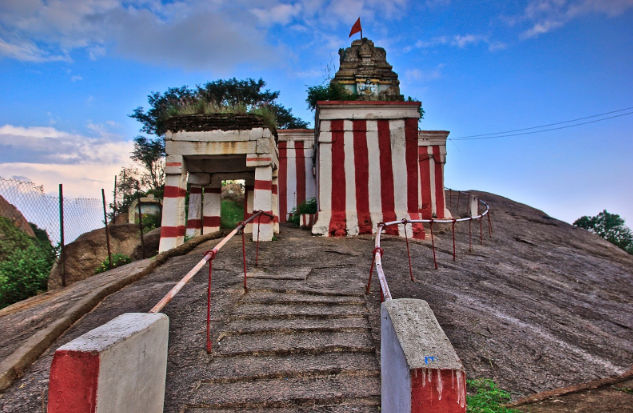Karnataka govt plans to develop 'Ramadevarabetta' as ‘Ayodhya of the South’; What is the significance of the place?
There is a strong belief among the people of the region that Sugriva (Ramayana) installed Ramadevarabetta
Total Views |
Karnataka's Bommai government is planning to develop Ramadevarabetta in Karnataka’s Ramanagara district as the ‘Ayodhya of the South’, sources recently shared. This comes after a letter written by a minister urging for developing the place.

Dr. C.N. Ashwath Narayan, District in-charge Minister of Ramanagara and Minister for Higher Education, IT and BT has written to Chief Minister Basavaraja Bommai and Muzrai Minister Shashikala Jolle, Narayan demanding that Ramadevarabetta be developed as the 'Ayodhya of South India’. Sources said that Sri Ram temple would be built using 19 acres of space which belong to the Department of Muzrai at Ramadevarabetta.
Ashwath Narayan also stated in the letter that the place is a prominent vulture conserved area in the country which would help to portray culture as well as nurture tourism. He also urged Chief Minister Basavaraja Bommai to constitute a development committee to build the temple at Ramadevarabetta on the lines of Sri Ram temple at Ayodhya. There is a strong belief among the people of the region that Sugriva (Ramayana) installed Ramadevarabetta. Considering the religious feelings of the people of the district, BJP is considering developing Ramadevarabetta as a heritage and attractive tourist spot.
It is also believed that Sri Rama spent a year here during his days of exile in the forest, along with Sita and Lakshmana. They also believe that seven great sages did their penance here. The traditional connection between Ramadevarabetta and Ramayana dates back to the era of ‘Tretayug’. Ramadevarabetta is located at a distance of 50 km from Bengaluru on the Bengaluru-Mysuru highway. Ramadevarabetta is a hill located in the Chamarajanagar district of Karnataka and is in the western ghats, renowned for its scenic beauty and biodiversity. The hill is home to a variety of plant and animal species, and is a popular spot for trekking and hiking.
It is also home to the Rangaswamy Betta Temple, which is dedicated to the Hindu god Ranganatha. Ranganatha is believed to be a form of the Hindu god Vishnu, who is one of the principal deities of the Hindu dharma. He is typically depicted in a reclining position on the coils of the serpent king Ananta, and is often accompanied by two goddesses: Lakshmi and Bhudevi.
K'taka Govt has announced to renovate the Ramdevara Betta mandir as a GRAND RAM MANDIR🚩
— The Analyzer (News Updates🗞️) (@Indian_Analyzer) January 2, 2023
CM Yogi will also inspect the land. It is believed that Shri Ram spent 1 year of his exile in this temple. This was constructed by Sugreev.
Lakshmi is the goddess of prosperity, wealth, and good fortune, and is often depicted standing at the feet of Vishnu. Bhudevi is the personification of the earth, and is often depicted standing at the head of Vishnu. Together, Lakshmi and Bhudevi represent the material and spiritual aspects of existence, respectively, and serve as the divine consorts of Vishnu.
Ranganatha is considered to be a very important deity in Vaishnavism, a major tradition within Hindu dharma, that worships Vishnu and his incarnations as the supreme being. Ranganatha is also one of the most popular deities in South India, and is revered by millions of Hindus worldwide.
In fact, when looked at it closely, there are quite a few interesting facts that are observed to be as similarly mentioned in the Ramayana as it is in reality. The Aranya Kanda of the Ramayana mentions about 'Jatayu' the King of Vultures who fights to death with Ravana, while saving Sita from the abduction. Interestingly, 'Ramanagara' is one of the few vulture sanctuaries across India & Asia.
Other than this, there are several incidents from the epic Ramayana that are related with the location of Ramadevara Betta. It is believed that Bhagwan Rama during his 14 years of exile, stayed and spent some time here. However, he was here alone or with Sita Mata and Lakshmana is yet debatable among the masses, as people here believe that Bhagwan Rama was accompanied with Sita Mata and brother Lakshamana while he was staying at Betta, however, the widely accepted place of Sita-apharan (the site of Sita Mata's abduction) is Panchavati which is located in Nashik.
It is also believed that when Bhagwan Rama was here for his visit, he had installed a Linga known as Sri Rameshwara to offer daily worship to Shiva. The place was constructed as a temple during Sri Kempegowda's rule in the sixteenth century. The hill also has a place titled Rama tirtha that is a beautiful spring between two temples. The spring is believed to be created by Bhagwan Rama when he shot an arrow in the rock there, in order to get drinking water. Although the depth of the spring is not known, locals believe the water also has many medicinal properties and is capable to heal many incurable diseases.
--

